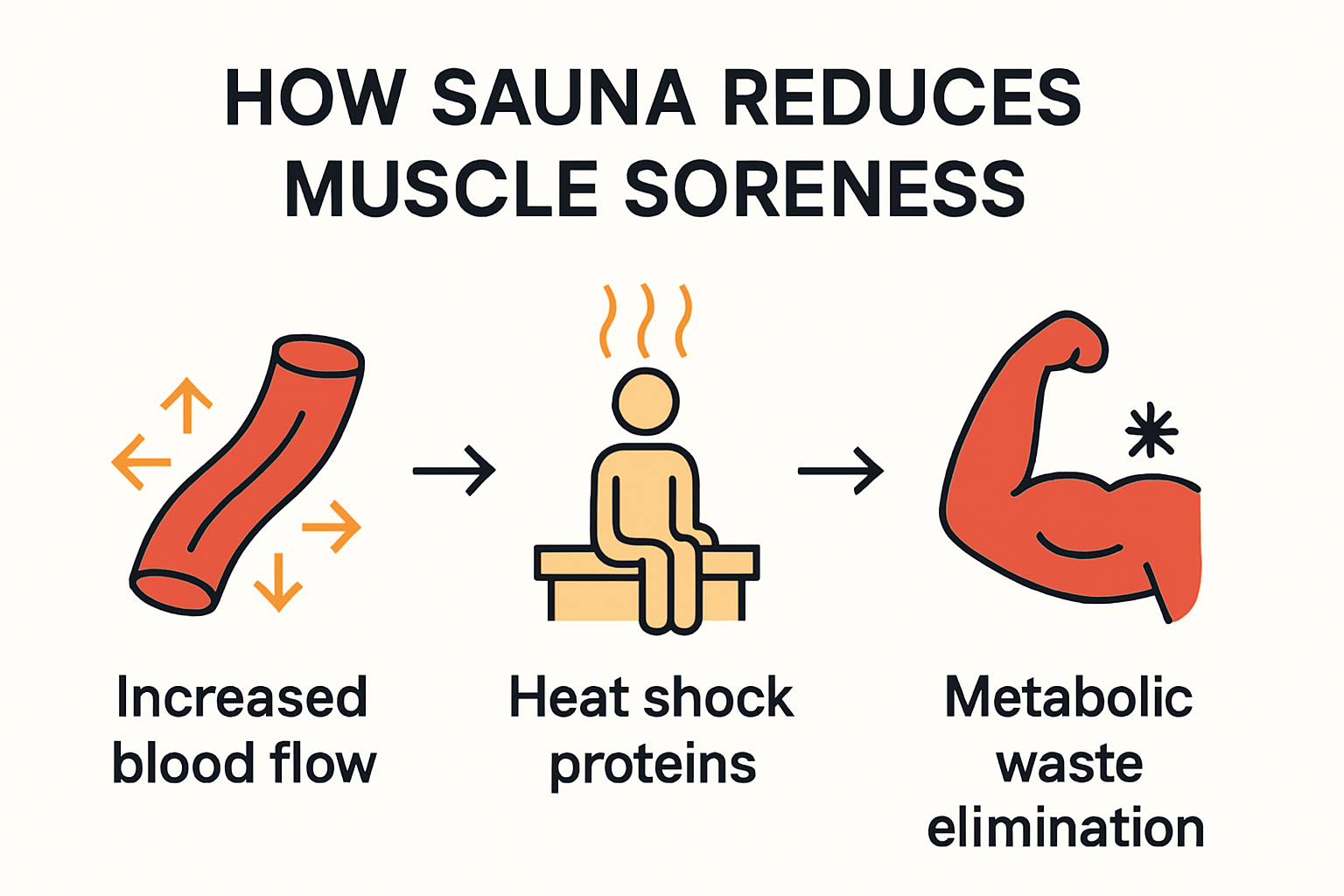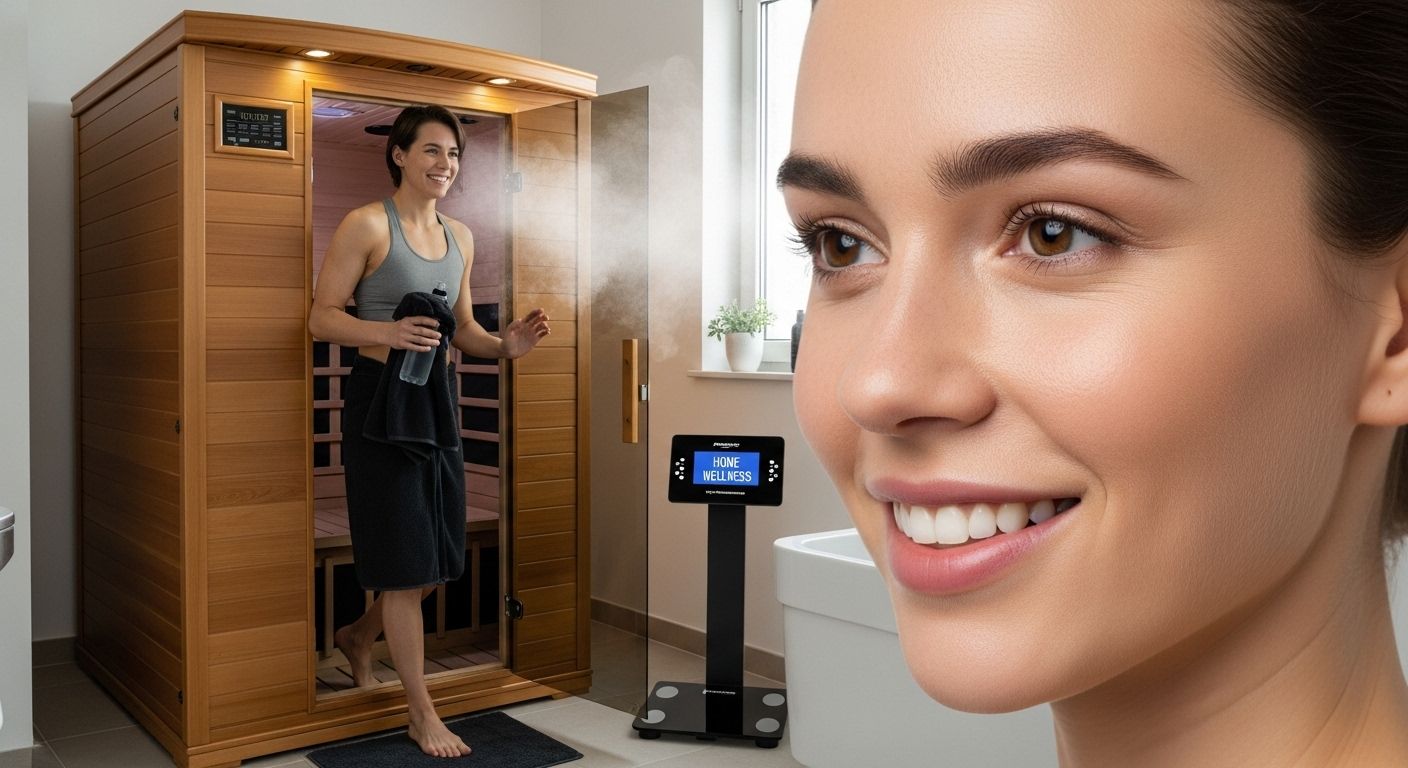
Why Sauna Is Good for Muscles: Top Benefits Explained 2025

Muscle pain and post-workout soreness can leave even the most dedicated athletes sidelined. Surprisingly, using a sauna after exercise can cut muscle recovery time by up to 50 percent according to recent studies. While most people think of saunas as just a way to relax, the real magic happens deep within your muscles, where heat unlocks powerful science-backed healing and performance benefits.
Table of Contents
- How Saunas Help Muscle Recovery
- Reducing Muscle Soreness With Sauna Use
- Saunas And Their Impact On Muscle Performance
- Choosing The Right Sauna For Home Wellness
Quick Summary
| Takeaway | Explanation |
|---|---|
| Saunas enhance muscle recovery significantly. | Using saunas post-exercise increases blood flow and nutrient delivery, promoting faster healing for muscle tissues. |
| Heat exposure reduces muscle soreness effectively. | Sauna sessions can alleviate delayed-onset muscle soreness by improving circulation and stimulating cellular repair mechanisms. |
| Strategic sauna use improves performance. | Regular sauna use enhances neuromuscular function and endurance, positively impacting overall athletic performance and recovery. |
| Choose the right sauna for best results. | Selecting between traditional steam and infrared saunas depends on personal comfort, heat sensitivity, and recovery goals. |
| Stay hydrated during sauna sessions. | Proper hydration before, during, and after sauna use is essential for effective recovery and overall health benefits. |
How Saunas Help Muscle Recovery
Muscle recovery represents a critical aspect of fitness and athletic performance, and saunas have emerged as a powerful tool in supporting this essential process. Beyond simple relaxation, sauna sessions offer a scientifically backed approach to enhancing muscle healing and reducing post-exercise strain.
The Physiological Mechanism of Heat Therapy
When muscles experience intense physical activity, microscopic damage occurs, triggering an inflammatory response. Sauna use strategically interrupts this process through targeted physiological mechanisms. Research published in the Journal of Clinical Rehabilitation reveals that heat exposure can significantly reduce muscle damage and accelerate recovery time.
The heat from saunas triggers several key physiological responses that directly benefit muscle recovery. Blood circulation increases dramatically, allowing more oxygen and nutrients to reach damaged muscle tissues. This enhanced blood flow helps remove metabolic waste products more efficiently, reducing muscle soreness and inflammation. Additionally, heat exposure stimulates the production of heat shock proteins, which play a crucial role in cellular repair and protection.
Enhanced Muscle Performance and Healing
Research from the Journal of Human Kinetics demonstrated that participants who incorporated infrared sauna sessions after resistance training experienced remarkable improvements in muscle recovery. The study found significant reductions in muscle soreness and enhanced neuromuscular performance compared to control groups.
Heat exposure activates the body’s natural healing mechanisms through a process called hormesis. By subjecting muscles to controlled thermal stress, saunas stimulate the Akt/mTOR pathway, a critical biological mechanism responsible for muscle protein synthesis and repair. Scientific literature on whole-body hyperthermia confirms that this pathway is instrumental in maintaining muscle mass and supporting rapid recovery.
Optimal Sauna Strategies for Muscle Recovery
To maximize muscle recovery benefits, timing and duration of sauna sessions are crucial. Experts recommend using saunas either immediately after intense workouts or within a few hours post-exercise. Typical sessions ranging from 15 to 30 minutes can provide significant physiological advantages. However, individual tolerance varies, so it is essential to listen to your body and stay hydrated.
While saunas offer remarkable muscle recovery benefits, they should complement a comprehensive recovery strategy. Proper nutrition, adequate rest, and appropriate stretching remain fundamental to optimal muscle healing. Saunas serve as a powerful supplementary tool, accelerating the body’s natural recovery processes and potentially reducing muscle soreness and potential long-term strain.
By understanding the science behind sauna-assisted muscle recovery, athletes and fitness enthusiasts can strategically incorporate heat therapy into their training regimens, promoting faster healing, reduced inflammation, and enhanced overall physical performance.
Reducing Muscle Soreness With Sauna Use
Muscle soreness represents a common challenge for athletes, fitness enthusiasts, and active individuals, often limiting performance and causing significant discomfort. Sauna use emerges as a promising natural strategy for mitigating and managing post-exercise muscle pain, offering a holistic approach to recovery that extends beyond traditional methods.
Understanding Muscle Soreness Mechanisms
Research published in the Journal of Clinical Research provides compelling insights into how sauna sessions can effectively reduce muscle soreness. The study revealed that participants who used saunas before intense physical activity experienced significantly less reduction in muscle strength and range of motion compared to control groups. This groundbreaking research highlights the preventative potential of heat therapy in managing exercise-induced muscle damage.
Delayed-onset muscle soreness (DOMS) occurs when microscopic muscle fiber tears develop during intense or unfamiliar exercise. The body’s inflammatory response triggers pain and stiffness, typically peaking 24 to 72 hours after physical activity. Sauna use interrupts this process by promoting enhanced blood circulation and accelerating the body’s natural healing mechanisms.
Physiological Recovery Through Heat Exposure
A study in the Journal of Human Kinetics demonstrated remarkable improvements in neuromuscular recovery among athletes who incorporated far-infrared sauna sessions after training. Participants who underwent 30-minute sauna sessions showed significant enhancements in performance metrics, particularly in counter-movement jump capabilities.
The physiological benefits of sauna use for muscle soreness include:
- Increased Blood Circulation: Heat causes blood vessels to dilate, improving nutrient delivery and waste removal from muscle tissues
- Accelerated Metabolic Waste Elimination: Enhanced sweating helps flush out inflammatory compounds
- Muscle Protein Repair: Heat stress stimulates cellular repair mechanisms

Optimal Sauna Strategies for Muscle Recovery
Medical experts from Medical News Today emphasize that strategic sauna use can significantly alleviate muscle pain and improve joint mobility. To maximize muscle soreness reduction, consider these professional recommendations:
- Timing: Use sauna sessions within 2-3 hours post-exercise for optimal recovery
- Duration: Aim for 15-30 minute sessions at temperatures between 150-195 degrees Fahrenheit
- Hydration: Drink plenty of water before, during, and after sauna use to support recovery processes
While saunas offer remarkable benefits for muscle soreness, they should complement a comprehensive recovery strategy. Proper nutrition, adequate rest, and targeted stretching remain fundamental to complete muscle healing. Saunas serve as a powerful supplementary tool, helping athletes and fitness enthusiasts manage post-exercise discomfort more effectively.
By understanding and implementing scientifically-backed sauna strategies, individuals can potentially reduce muscle soreness, enhance recovery speed, and maintain peak physical performance across various athletic and fitness pursuits.
Saunas and Their Impact on Muscle Performance
Muscle performance represents a critical component of athletic achievement and overall physical fitness. Saunas have emerged as a powerful tool for athletes and fitness enthusiasts seeking to optimize their muscular capabilities through innovative heat therapy techniques.
Neurological and Physiological Performance Enhancement
Research published in the Journal of Human Kinetics demonstrates compelling evidence of sauna’s profound impact on neuromuscular performance. The study revealed that post-exercise infrared sauna sessions significantly improved athletes’ recovery and neuromuscular function, suggesting a direct correlation between heat exposure and muscular efficiency.
The heat stress experienced during sauna sessions triggers a complex cascade of physiological responses. Thermal adaptation activates heat shock proteins, which play a crucial role in cellular protection and performance optimization. These proteins help muscles become more resilient to stress, potentially improving overall muscular endurance and recovery speed.
Cardiovascular Conditioning and Muscle Performance
A randomized controlled trial in the American Journal of Physiology uncovered remarkable connections between sauna use and cardiovascular conditioning. Regular sauna bathing demonstrated significant improvements in cardiovascular function, which directly impacts muscle performance through enhanced oxygen delivery and metabolic efficiency.
The cardiovascular benefits of sauna use include:
- Improved Blood Circulation: Enhanced blood flow supports more efficient nutrient and oxygen delivery to muscle tissues
- Increased Plasma Volume: Better blood plasma regulation supports muscular endurance
- Accelerated Metabolic Processes: More efficient energy utilization during physical activities
Prophylactic Effects on Muscle Performance
Research in the Asian Journal of Sports Medicine highlighted the prophylactic potential of sauna use in preventing muscle performance degradation. The study showed that strategic heat exposure can mitigate potential muscle damage and maintain functional capabilities, particularly during intense training periods.
Athletes and fitness enthusiasts can leverage sauna sessions to:
- Enhance muscular recovery and reduce potential performance limitations
- Improve overall thermal tolerance and stress adaptation
- Support long-term muscular resilience and performance potential
Strategic sauna integration requires careful consideration of individual fitness levels, training intensity, and personal health conditions. While the potential benefits are significant, it is crucial to approach sauna use as a complementary technique to comprehensive training and recovery strategies.
By understanding the intricate relationship between heat exposure and muscle performance, individuals can develop more sophisticated approaches to athletic training and physical conditioning. Saunas offer a scientifically supported method for pushing physiological boundaries and unlocking enhanced muscular potential.
Choosing the Right Sauna for Home Wellness
Selecting the ideal sauna for home wellness involves careful consideration of multiple factors that impact overall health benefits, personal preferences, and practical implementation. Understanding the nuanced differences between sauna types can help individuals make informed decisions that align with their specific wellness goals.
Types of Saunas and Their Unique Benefits
Research published in the Mayo Clinic Proceedings provides comprehensive insights into various sauna technologies and their distinct physiological impacts. The primary sauna categories include traditional steam saunas, dry saunas, and infrared saunas, each offering unique advantages for muscle recovery and overall wellness.
Traditional Steam Saunas operate at high temperatures between 150-195 degrees Fahrenheit, creating a humid environment that induces intense sweating. These saunas promote deep heat penetration and provide a classic sauna experience that many wellness enthusiasts appreciate. The high heat and humidity stimulate cardiovascular responses and enhance metabolic processes.
Infrared Saunas represent a modern approach to heat therapy, utilizing electromagnetic waves that directly warm body tissues. Unlike traditional saunas, infrared models operate at lower temperatures while providing deeper tissue penetration. These saunas offer more targeted heat exposure, potentially making them more comfortable for individuals sensitive to extreme temperatures.

Below is a table comparing the main sauna types and their unique benefits, as explained in this section:
| Sauna Type | Temperature Range | Main Features/Benefits |
|---|---|---|
| Traditional Steam Sauna | 150-195°F (high heat) | Humid environment, intense sweating, classic sauna experience |
| Dry Sauna | 150-195°F (high heat) | Low humidity, deep heat, stimulates cardiovascular system |
| Infrared Sauna | Lower than 150°F | Deeper tissue penetration, targeted heat, more comfort for sensitive users |
Practical Considerations for Home Sauna Selection
When choosing a home sauna, several critical factors demand careful evaluation:
- Space Requirements: Measure available space and consider compact designs for smaller areas
- Electrical Compatibility: Verify home electrical systems can support sauna power needs
- Budget Constraints: Evaluate initial purchase costs and long-term operational expenses
- Material Quality: Prioritize saunas constructed from durable, non-toxic materials like cedar or hemlock
Personal health goals should drive the selection process. Individuals focusing on muscle recovery might prioritize infrared models, while those seeking traditional therapeutic experiences may prefer steam-based options. The key is matching sauna technology with specific wellness objectives.
Installation and Maintenance Insights
Successful home sauna integration extends beyond initial selection. Proper installation and ongoing maintenance represent crucial elements of a sustainable wellness strategy. Consider professional installation to ensure electrical safety and optimal performance. Regular cleaning, wood treatment, and electrical system checks will prolong sauna lifespan and maintain peak functionality.
The table below summarizes key installation and maintenance considerations for home sauna owners:
| Task | Recommendation/Notes |
|---|---|
| Professional Installation | Ensures electrical safety and optimal performance |
| Session Duration | Start with 10-15 minutes; increase as tolerated |
| Hydration | Maintain before, during, and after sauna use |
| Regular Cleaning | Prolongs sauna lifespan, maintains hygiene |
| Wood Treatment | Protects sauna materials (cedar, hemlock) |
| Electrical System Checks | Prevents malfunctions and ensures safety |
| Health Consultation | Especially for individuals with pre-existing medical conditions |
Additional recommendations for home sauna wellness include:
- Start with shorter sessions (10-15 minutes) and gradually increase duration
- Maintain consistent hydration before, during, and after sauna use
- Consult healthcare professionals, especially for individuals with pre-existing health conditions
Investing in a home sauna represents a commitment to personal health and wellness. By carefully evaluating technological features, understanding personal health requirements, and implementing proper maintenance strategies, individuals can transform their home wellness experience. The right sauna becomes more than an appliance it becomes a powerful tool for muscle recovery, stress reduction, and overall physiological optimization.
Frequently Asked Questions
How does sauna use help muscle recovery?
Using a sauna promotes increased blood circulation, oxygen delivery, and nutrient supply to damaged muscle tissues, significantly enhancing the muscle recovery process after intense workouts.
What is the optimal sauna duration for muscle recovery?
Experts recommend sauna sessions lasting between 15 to 30 minutes for effective muscle recovery, ideally conducted immediately after or within a few hours post-exercise.
Can sauna sessions reduce muscle soreness?
Yes, sauna sessions help alleviate delayed-onset muscle soreness (DOMS) by improving circulation, reducing inflammation, and stimulating the body’s natural healing mechanisms.
What types of saunas are best for muscle recovery?
Traditionally, both steam and infrared saunas offer unique benefits. Infrared saunas tend to provide deeper tissue penetration at lower temperatures, which may be more comfortable for those sensitive to heat, while traditional saunas offer intense humidity and heat for an invigorating experience.
Unlock Faster Muscle Recovery at Home with Best Life Sauna
Are you tired of persistent muscle soreness holding you back, even after putting your all into training? This article explained how targeted heat therapy, improved circulation, and the right sauna strategy can make a dramatic difference in how quickly your muscles heal. At Best Life Sauna, we make these science-backed recovery benefits part of your daily routine with premium sauna options for every lifestyle.

Choose your path to recovery and wellness now. Explore our wide range of infrared and traditional saunas tested for optimal muscle performance and relief. Ready for deeper relaxation and a faster comeback after every workout? Discover exclusive promotions and get expert support every step of the way at Best Life Sauna. Your wellness upgrade starts today.

